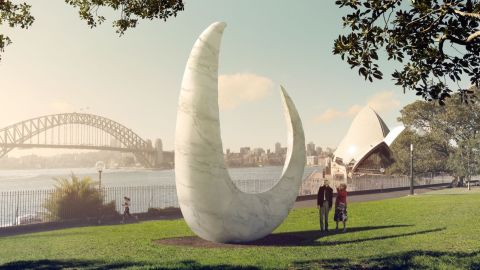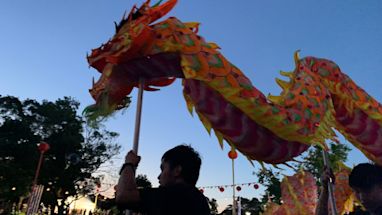A major new artwork overlooking Sydney Harbour above Dubbagullee (Bennelong Point) will honour the clans of the Eora nation and the skills of Eora women.
bara by Aboriginal artist Judy Watson is modelled after the crescent shapes of bara – traditional fish hooks crafted and used by local women for thousands of years.
Eora women were the main food providers for their families, and the new artwork recognises this huge responsibility. Women fished from their bark canoes (nowie or nawi) with lines and hooks, while men stood along the shoreline with fish gigs.
Eora fisherwomen
Fish was a staple food for people along the coast and harbour. Women made their fishing lines (carr-e-jun) by twisting together 2 strands of fibre from kurrajong trees, cabbage trees or flax plants. Sometimes animal fur or grass was used.

The distinctively crescent-shaped fish hooks, called burra or bara, were honed from the broadest part of the turban shell. The pearly reflection of the hook would have acted as a lure.
The women did not use bait but spat chewed shellfish on the surface of the water.
The greatest ingenuity
European naval officers admired the technical accomplishment required for these essential tools. First Fleet surgeon George Worgan thought they showed ‘the greatest ingenuity’ of all the Eora implements.

The skill of the women in catching the fish and navigating the changeable harbour conditions in their modest nawi was also greatly admired.
Their skills were described in detail in journals and captured through multiple watercolours. These artworks show Eora fisherwomen in nawi with fires going, fishing, minding and feeding their small children.

The fisherwomen were a common sight around Port Jackson for generations, singing as they rowed and fished.
They dominated the waters of the harbours, coves and bays, and the coastlines in between.
The bara and lines were sometimes worn by Eora fisherwomen around their necks like a necklace. Although the hooks were beautiful, pearly and finely made, they weren’t worn as a frivolous piece of jewellery, but rather an essential working implement.
They were also a symbol of women’s identity, power and status.
Originally written by Lisa Murray, City historian and published on the Dictionary of Sydney.
Published 21 August 2018, updated 23 February 2022



